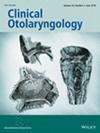Evaluation and Outcomes of Iatrogenic Oropharyngeal Dysphagia
Abstract
Objective
To investigate the outcomes of iatrogenic oropharyngeal dysphagia and compare them with outcomes from different types of dysphagia aetiologies.
Study Design
Retrospective analysis.
Setting
This study was conducted on patients evaluated at a tertiary hospital's Swallowing Disorder Center using physical examination and fibreoptic endoscopic evaluation of swallowing (FEES) between January 2015 and October 2021.
Methods
Patients were divided into six groups according to the potential cause of dysphagia: (1) Post head and neck cancers (HNCs) treatment; (2) Post-surgery for non-cancerous aetiology; (3) Neurological; (4) Intracranial; (5) Head and neck pathology; and (6) Others. Of these, the first and second groups comprise dysphagia caused by treatment (iatrogenic dysphagia). FEES results were analysed using the Swallowing Performance Status Scale (SPSS) and the Penetration Aspiration Scale (PAS).
Results
Of the 507 patients included, 146 (28.8%) had iatrogenic dysphagia, and 361 (71.2%) had non-iatrogenic dysphagia. After swallowing therapy, 138 patients underwent a follow-up FEES examination (47 patients with iatrogenic dysphagia and 91 patients with non-iatrogenic dysphagia). After swallowing intervention (compensatory technique and food consistency changes), the follow-up FEES examination revealed significant improvement in the non-iatrogenic group (p < 0.001), while the iatrogenic group showed no significant improvement after intervention. PAS and SPSS scores also demonstrated greater improvement in the non-iatrogenic group.
Conclusions
This study emphasises that iatrogenic dysphagia is a common entity in the swallowing disorders outpatient ENT clinic. It is more likely to persist and resist conventional swallowing therapy, leading to worse outcomes compared to non-iatrogenic dysphagia.

 求助内容:
求助内容: 应助结果提醒方式:
应助结果提醒方式:


